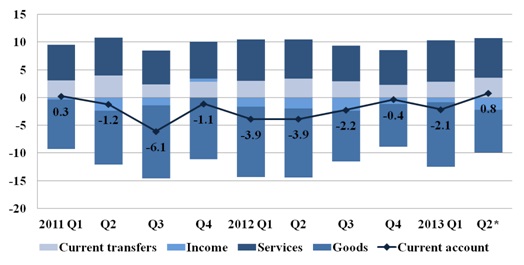Latvia’s balance of payments in the second quarter of 2013
A surplus of 32.3 mil. lats (0.8% of the predicted gross domestic product, GDP, see Figure) formed in the Latvian balance of payments in the second quarter of 2013 and thus, overall in the first six months, there has been a small deficit in the current account (only 44.9 mil. lats or 0.6% of predicted GDP). The year-on-year drop in the current account deficit has been determined by the drop in the goods external trade deficit.
Figure. Main components of current account, % of GDP.

Note. Data have been adjusted, beginning with first quarter 2012.
*Bank of Latvia GDP prediction was used in the calculation
The goods and services external trade deficit in the second quarter dropped to 24.4 mil. lats or 0.6% of predicted GDP. The year-on-year rise in goods and services exports was 4.7%, whereas their imports dropped by 2.9% year-on-year.
The goods external trade balance in the second quarter was reinforced by the shipments of passenger vessels built at JSC Riga Shipyard to Russia (according to statements by the company to the "Nasdaq OMX Riga" stock exchange, three ships were built and sold for the total sum of about 13.5 mil. lats). The Latvian export market shares continued to increase in Latvia’s main trading partners. Import amounts have been dropping since the beginning of the year, unfortunately also on account of intermediate consumption goods and capital goods: these goods are necessary for further growth of production and strengthening the export potential.
The exports of transportation and travel services have grown, in part under the impact of seasonal factors. Further development of the sector could be affected, if only briefly, by Russia’s decision to institute changes in the customs system. The amount of transport services could benefit from the decision of Ldz Cargo Ltd to purchase instead of rent train cars, which would mean becoming more flexible in the planning and developing cargo shipments. What Latvia has to offer is, however, not limited to the traditional transportation sector. The exports of information and computer services have been expanding. The second quarter saw growth in the exports also of some smaller services sectors, for example, communication services and individual cultural and recreational services.
In the second quarter, there was an increase in money flows into the country in the form of current transfers, mostly consisting of payments received from European Union (EU) funds. Overall 212.1 mil. lats was received from EU funds in the second quarter. For that reason, we can assess that the 1.2 mil. euro, which Latvia will have to pay back to the EU for inadequately used funds, will not have a substantial impact on the Latvian balance of payments statistics. This sum is relatively small compared to all the funding received from the EU, constituting a mere 0.4% of financing received only in this quarter.
The negative balance of the financial account increased to 77.1 mil. lats or 1.9% of the predicted GDP. There was an inflow of 121.9 mil. lats (3.0% of predicted GDP) of foreign direct investment. Mostly foreign direct investment in Latvia increased in financial and insurance activities (mostly from the U.S. and Sweden) and in manufacturing (mostly from Cyprus, Estonia and Denmark).
Generally, the data on the current account of the Latvian balance of payments in the first six months as well as trends in economic development point to the current account deficit remaining small in 2013 overall.
Textual error
«… …»






